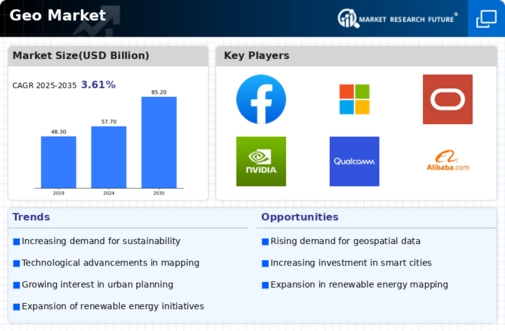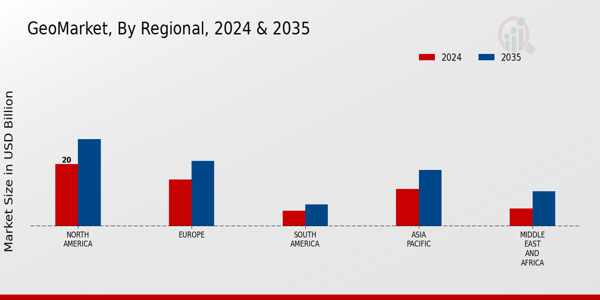Market Growth Projections
The Global Geo Market Industry is poised for substantial growth, with projections indicating a market size of 57.7 USD Billion in 2024 and an anticipated increase to 85.2 USD Billion by 2035. This growth trajectory reflects the increasing reliance on geo-spatial data across various sectors, including urban planning, environmental management, and disaster response. The industry is expected to experience a compound annual growth rate (CAGR) of 3.61% from 2025 to 2035, highlighting the ongoing demand for innovative geo-data solutions and technologies.
Technological Advancements
The Global Geo Market Industry is experiencing a surge in technological advancements that enhance data collection and analysis. Innovations such as satellite imagery, Geographic Information Systems (GIS), and remote sensing technologies are revolutionizing how geographical data is utilized. These technologies enable more accurate mapping and spatial analysis, which is crucial for urban planning, environmental monitoring, and disaster management. As a result, the industry is projected to reach 57.7 USD Billion in 2024, driven by the increasing demand for precise geographical information across various sectors.
Integration of Big Data and AI
The integration of big data analytics and artificial intelligence (AI) into the Global Geo Market Industry is transforming how geographical information is processed and utilized. These technologies enable the analysis of vast datasets, leading to more informed decision-making and predictive modeling. For instance, AI algorithms can identify patterns in geographical data that may not be apparent through traditional methods. This integration enhances the capabilities of geo-spatial applications in various sectors, including agriculture, transportation, and public health, thereby driving market growth and innovation.
Growing Demand for Urban Planning
Urbanization is a significant driver in the Global Geo Market Industry, as cities expand and require effective planning solutions. The need for sustainable urban development has led to an increased reliance on geographical data to inform infrastructure projects, transportation systems, and resource management. Governments and municipalities are investing in geo-spatial technologies to optimize land use and improve public services. This trend is expected to contribute to the industry's growth, with projections indicating a market size of 85.2 USD Billion by 2035, reflecting the critical role of geo-data in shaping urban environments.
Government Initiatives and Funding
Government initiatives and funding are crucial drivers of growth in the Global Geo Market Industry. Many governments are recognizing the importance of geo-spatial data for national security, infrastructure development, and environmental management. As a result, they are investing in geo-data projects and establishing policies that promote the use of geographical information systems. These initiatives not only enhance the capabilities of public services but also stimulate private sector involvement in geo-data solutions, contributing to the overall expansion of the market.
Environmental Monitoring and Management
The Global Geo Market Industry plays a vital role in environmental monitoring and management, particularly in the context of climate change and natural resource conservation. Geographic data is essential for tracking environmental changes, assessing biodiversity, and managing natural disasters. Organizations and governments utilize geo-spatial technologies to develop strategies for sustainable resource use and environmental protection. As awareness of environmental issues grows, the demand for geo-data solutions is likely to increase, supporting a compound annual growth rate (CAGR) of 3.61% from 2025 to 2035.



















Leave a Comment